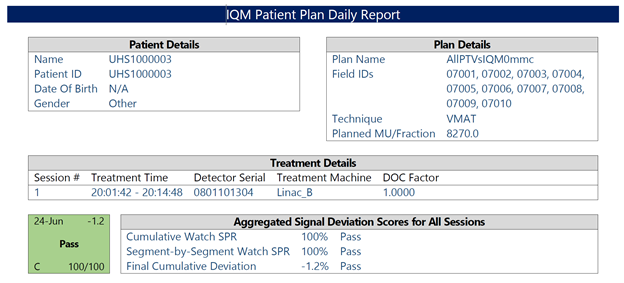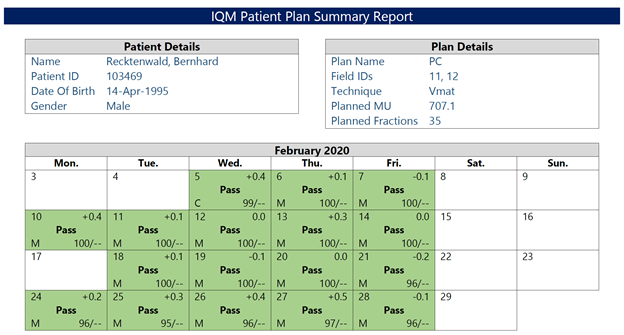The recently released IQM software version 1.8 offers a variety of unique clinical features. For example, the IQM Monitor Application offers increased flexibility, with expanded Watch and Action Level options like asymmetric threshold definition for upper- and lower-level deviations and many more.
The new IQM Reports document every step of the treatment delivery process with unprecedented detail.
The new IQM reports do not just provide insights into the quality of the treatment, but also into the accuracy of every step of the treatment delivery process.
Three new reports are available:
-
- IQM Calculation Report: Documents the conversion of the treatment plan information into IQM related reference data.
- Patient Plan Daily Report (PPDR): Presents the verification results of a single day’s delivery of a given plan.
- Patient Plan Summary Report (PPSR): Summarizes and evaluates the entire course of treatment as if it were a single delivery.
The Patient Plan Daily Report (PPDR) contains the verification results of a single day’s treatment fraction. The PPDR starts with an evaluation of the overall plan delivery: aggregated signal deviation scores for all delivered beams of a treatment plan combined.

The PPDR reports Final Cumulative Deviations as well as cumulative and segment-by-segment Signal Pass Rates for the entire plan, including all beams, and for each beam individually. Signal Pass Rates indicate the percentage of a delivery that stayed within the user-defined tolerance.
Uniquely, the PPDR goes on to provide detailed results of every individual beam segment at every single control point.
The PPDR evaluates the entire signal curve, detecting not just systematic errors, but also random delivery errors at single beam segments.
The Patient Plan Summary Report (PPSR) summarizes the detailed verification results of each treatment fraction in a calendar-style summary and evaluates the entire course of treatment as if it were a single delivery.

The IQM Report Service creates these reports fully automatically, without any user interaction, then sends them to authorized users via e-mail and/or stores them at a specified network location.
Elekta Mosaiq users can also choose to automatically import and attach the reports to their electronic patient files, again without any user interaction.
